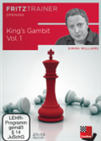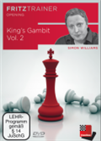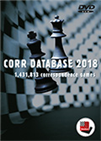Simon Williams's King's Gambit Vol. 1 & Vol. 2
A review
If one likes to play 1.e4 the occasional King's Gambit is a must. It brings the opponent on the territory we choose for the battle, instead of letting Black decide where to go. Even so, the theory is huge, partly because it has been played for over 100 years. Then, of course, the introduction of powerful chess engines has re-evaluated every opening. I love this opening, and I'd like to share this passion through some games, that in my opinion, everyone should know. I divided the games by World Champion, so one can quickly review the way different champions interpreted the King's Gambit.
 This DVD concentrates on the King's Gambit accepted with 3.Bc4. Williams has included a lot of novelties and interesting attacking variations that should wet the lips of any attacking player, looking for an interesting way of meeting 1...e5!
This DVD concentrates on the King's Gambit accepted with 3.Bc4. Williams has included a lot of novelties and interesting attacking variations that should wet the lips of any attacking player, looking for an interesting way of meeting 1...e5!
Boris Spassky in 1969 | Photo: Published by the Embassy of the USSR to the USA (uncredited) [Public domain], via Wikimedia Commons
The first one is Spassky. He is quite known for the match against Fischer, and yet relatively few books have been written on him compared to other world champions.
While the five games above are just an appetiser, are there other big names which could inspire us to adopt this opening as part of our opening repertoire?
The next one is Bronstein, whose name is synonymous with creative play. In the King's Gambit, one can often see fireworks in the opening, with incredible intricacies not to mention the sheer amount of lines one should calculate. This could add another plus for those who excel in rapid time controls. Don't miss the game Bronstein vs Tal, which could be titled: When the Sorcerer met the Magician!

But what about a real modern champion, is there someone still playing it at a high level? Does the name Ivanchuk ring any bells?
The names of those beaten by Ivanchuk should be familiar too: Giri, Karjakin, Nakamura...
 Some of the most interesting lines in the King’s Gambit starting with 3 Nf3, especially concentrating ‘on the refutation of the King’s Gambit (Fischer)’ 3...g5. And what happens if Black does not play 2...exf4 is covered.
Some of the most interesting lines in the King’s Gambit starting with 3 Nf3, especially concentrating ‘on the refutation of the King’s Gambit (Fischer)’ 3...g5. And what happens if Black does not play 2...exf4 is covered.
Ivanchuk in 2008 — he has played the King's Gambit for decades | Photo: Andreas Kontokanis (CC BY 2.0) via Flickr
 Corr Database 2018 is an extensive collection of correspondence games, featuring classical correspondence games played by mail as well as email games.
Corr Database 2018 is an extensive collection of correspondence games, featuring classical correspondence games played by mail as well as email games.Some players could have the opinion that the King's gambit is an opening to take someone by surprise, but not a sound opening one could use for all situations.
Lately, to prepare my openings, I've begun to use the ChessBase Correspondence Database 2018. Why? Because from the year 2000 onward most correspondence games have been played by centaurs (humans assisted by an engine) and if an opening is not theoretically sound, nobody would use it against an engine, because they would already know the result.
Instead in such database, I found over ten thousand games played from the years 2002 up to 2018 with the King's Gambit! Now, I'm not saying these games are perfect. But if one has 2-3 days per move, and the use of an engine, surely the quality should be superior to a tournament game, where even a top player has 2-3 minutes per move. Keep in mind when you see a 2400 rated centaur, that is still over 3200 of human ratings.
What is the advantage of having seen all these games? Now you are ready to better pick up and reinforce all the lessons dispensed by GM Williams. Thanks to his jocular style one doesn't get bored or sleepy while listening to the videos, and of course, it doesn't hurt to know some of the themes, moves and ideas used by these champions in their own games.
Williams has recorded two video series: the first one is dedicated to the King's Gambit Accepted, especially focusing on 2.Bc4 — the move he recommends. The first series runs for over five hours (more than 20 videos), and Williams adds a lot of new ideas, going for a level of proficiency in the King's Gambit which is quite beyond the amateur or club level.
Thanks to the ChessBase's tools, I try most of the lines explained by Williams against Fritz and see what are the problems. I do it also to see if I understood and remember what he explained. For example in the first video series, Williams gives the choice between two lines. I put these two lines in the diagrams under, so one can test them against the engine:
1.e4 e5 2.f4 exf4 3.Bc4 Nc6 and here Williams recommends 4.d4 Nf6! 5.Nc3 Bb4!
But worth a try is: 1.e4 e5 2.f4 exf4 3.Bc4 Nc6! 4.Nf3 g5!?
And now Williams would continue with 5.0-0 giving as evaluation: aggressive play for White. But in order to play an opening, one must actually try these lines and see how he or she feels about them.
Williams has done the homework for us because he has researched two of the main books on the King's Gambit, which he previously used as a reference in his own study and praxis. He has, in turn, added some novelties and ideas which we will be able to implement in our own games.
As always, in the new FritzTrainer DVDs, there are a series of interactive video clips, where Williams shows a position and asks viewers to find the right move, giving feedback when one finds it, or even when one doesn't. The first volume, as well as the second, comes with a database of 50 games, for a total of 100, which one should study to be well prepared, as well to avoid possible surprises since the games are quite recent.
The second volume covers all the other lines, and of course, those lines refusing to accept the gambit. As with the first volume, it too is over five hours!
I found the most interesting part of this video series related to the lines where Black refuses to accept the gambit because then one must come up with alternative plans.
For example, 1.e4 e5 2.f4 Bc5 is one of the favourite ways a friend of mine found to refuse the King's Gambit:
But also 1.e4 e5 2.f4 d5 must be taken seriously — the famous Falkbeer Counter-Gambit. Williams says it is an underrated move, which one must pay attention to.
I prepared a small sample of games, which will give an idea of the themes and dangers of such counter-gambit. The first one is by Anderssen vs Falkbeer, so one can witness opening history in the making. I included some games of the 'Father of Russian chess', because it shows how differently chess was played in that time, and how difficult was for him to solve the e3-square problem, a hole in White's territory.
In order to select these games I reviewed many by Steinitz and one can feel his superiority in understanding how to play the King's Gambit in his time.
But what is White's modern interpretation of how to fight against the Falkbeer's counter-gambit? Carlsen docet!
Another interesting move Black can play to refuse the gambit is: 1.e4 e5 2.f4 Nc6, Williams said this move was first investigated by Tony Miles, a great English player, and quite creative. Williams shows he did his historical homework too, by elucidating the interpretation of Miles, as Black, fighting against the King's Gambit, after the moves: 1.e4 e5 2.f4 Nc6 3.Nf3 f5
Williams warns that one needs to know what he is doing, hence I put the position here, so one can practice.
We need these DVDs, and Williams' guidance, because in our modern chess world of computers, trainers, videos etc. there is clearly an improved level of defence reached by the average club player. Thanks to the King's Gambit we can create unbalanced positions which ask the opponent to think, and that could provoke the errors we need to win the game.
Pros and Cons
Williams says he plays the King's Gambit for the romantic style. Personally, I believe the King's Gambit — as well as many other gambits — should be learned and played by all amateur players to get a better grasp of elusive chess concepts such as "time", "initiative", "value of the pieces in different phases of the game", etc. Practically speaking, I disagree with Williams to some extent when he says: "we are playing against humans, and we don't expect our opponents to play precisely" — like computers. This for me is not acceptable. We should always play our best and never for even one moment introduce the fallacy of: "Let's hope my opponent doesn't see that..." One also needs to understand today defensive technique is clearly better than 100 years ago, so to play "hope chess" is a recipe for a disaster over the board.
I play the King's gambit to keep my chess mind flexible. From the number of games I've seen, it's clear one can win while giving up a pawn, especially in the opening when the value is not so fixed like in the endgame. Chess is a violent sport, the fear of losing a game, and reputation is strong. Still, we need to learn. To put the journey before everything — because the journey is what makes life exciting.
However, I do understand some folks could be afraid of playing some lines proposed by Williams like 1.e4 e5 2.f4 exf4 3.Nf3 (his main recommendation is 3.Bc4, but I feel one should learn this, to learn about sacrifice) 3...g5 4.d4 g4 5.Bxf4! gxf3
I think this position should be played against Fritz, and one can set the engine at different strengths, and see how he scores.
By the way, I totally agree when Williams says: "I don't think you can be a full-fledged chess player if you didn't play the King's Gambit once in your life."
Final thoughts
Ten hours for learning a new opening are not much. Use another ten hours to review the games in the databases and another ten to play some blitz games, and smooth some edges. Eventually, before a weekend tournament, a player can also use this article to review the material. The games shown will provide a wealth of ideas on how to play the King's Gambit. Don't pass on the chance to play highly creative chess, and gain easy points! For those interested in keeping their opponents guessing, Williams has also made two DVDs on the English Opening. Clearly, it is quite difficult to prepare against someone who opens one game with the King's Gambit, and another with the English!
Williams main teaching method behind this set of two DVDs is to teach you some simple yet effective set ups, without the need to rely on memorising numerous complicated variations.
Links

























